Brendan I. Koerner's Blog, page 22
May 7, 2012
That’s All I Can Stands
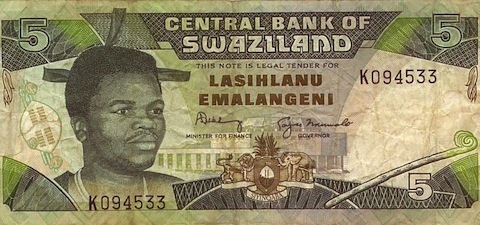
Will future historians look back upon Angela “LaGija” Dlamini as the great tea-leaf reader of Swazi politics? In recent days, her husband, the absolute monarch King Mswati III, has come under an unusual amount of fire for his profligacy—it is still tough to imagine, for example, why he merited a new $46 million jet, or a birthday party that would put Karen Kozlowski’s infamous shindig to shame. Dlamini perhaps sensed that her spouse was verging on his Marie Antoinette moment when she decided to split:
Angela “LaGija” Dlamini had been unhappy for a long time and had thought of leaving for many years, a royal guard told SSN. She left the palace to visit her parents in Hhohho, northern Swaziland. From there, she disappeared and was believed to be staying with relatives in the Mkhuzweni region of the country, said Lukhele.
LaGija is the third of the king’s wives to leave the royal household. According to a 2004 report in the Daily Sun, the first to flee was Delisa Magwaza, 30, known as Inkhosikati LaMagwaza, who made her way to London via Cape Town. She was followed by Putsoana Hwala, 30, known as Inkhosikati LaHwala, who left behind her three children.
Mswati’s 12th wife Mswati Nothando Dube, 22, known as Inkhosikati LaDube, was placed under house arrest at the home of the king’s mother in 2010 after an alleged affair with Swaziland’s justice minister Ndumiso Mamba. Mamba was fired.
Predicting the fall of a dictator is a mug’s game; strongmen have a way of clinging to power long after their popular support has entirely evaporated. But when even the most privileged members of the inner circle start fleeing, it’s not too much of a stretch to predict that a full implosion looms—though perhaps not until Swaziland’s richest neighbor decides to speed along the process by tightening its purse strings.
If nothing else, King Mswati III’s crooked reign reaffirms an old Microkhan axiom: Never put much faith in a regime that puts living political figures on its currency.
May 4, 2012
End of Act One

As you read these words today, I’ll be putting the finishing touches on my book manuscript—an 84,000-word tale of a young couple that pulled off an amazing heist many moons ago, then went roaming about the world. Tough to believe I’ve reached this point in the process; I started working on this project nearly three years ago, and there have been many moments when I’ve been tempted to chuck it all. Still a long way to go, but I can at least glimpse the shape of the finished product now.
One reason I’ve kept chugging along is a compulsion eloquently encapsulated by Chinese photographer Song Chao, so well-known for his portraits of coal miners. A former miner himself, Song was recently asked why he had turned his lens on subjects who most people rarely give a second thought to. His answer says a lot about the challenges and the allure of bringing characters to life in any artistic medium:
In people’s minds miners are ‘black’ people, leading a dull, mysterious and hard life. But this has nothing to do with reality, we often go out have drinks, grab something to eat, speak about our security, about women, and so forth. After six years of work in the mines, I spent more time with my colleagues than my family. In my mind, all their faces changed into unique characters. When I close my eyes I can perfectly imagine them in detail, I can even describe their personality, their opinion, the way they work. For me, these portraits embrace all the above-mentioned ideas.
We all know on some innate level that every human being is unique. But we often need to hear their stories to be reminded of that fact.
May 3, 2012
So Close, So Far Away
Just about thirty hours to go ’til my book deadline. Furiously trimming adverbs and trying to inject much-needed moments of humor and profundity. Sit tight.
May 2, 2012
Bad Reputation

As you may have noticed, I have a soft spot for walruses, who I like to think of as Nature’s couch potatoes. I was thus amused to learn that the self-styled scientists of the sixteenth century believed that these sedentary sacks of blubber were, in fact, agents of the Devil. Check out this 1539 description of walruses (then called Rosmari) from Olaus Magnus, who was sort of the Charles Darwin of his day (minus the genius or work ethic):
The Norway Coast, toward the more Northern parts, hath huge great Fish as big as Elephants, which are called Morsi, or Rosmari, may be they are so from their sharp biting; for if they see any man on the Sea-shore, and can catch him, they come suddenly upon hum, and rend him with their Teeth, that they will kill him in a trice. Therefore, these Fish called Rosmari, or Morsi, have heads fashioned like to an Oxes, and a hairy Skin, and hair growing as thick as straw or corn-reeds, that lye loose very laregely. They will raise themselves with their Teeth as by Ladders to the very tops of Rocks, that they may feed on the Dewie Grasse, or fresh Water, and role themselves in it, and then go to the Sea again.
I can only think that Magnus got his information from grog-addled sailors who were having a laugh. And yet his description of walruses became the conventional wisdom for roughly two centuries. Which makes me think we rather like tales that overhype the redness of Nature’s tooth and claw—they make us feel more secure in or tranquil surroundings, yet also more adventurous when we sally forth. I can only imagine that someone raised on Magnus’s walruses-as-fiendish-monsters fantasia was mightily confused upon first glimpsing the flabby mammals.
April 30, 2012
The East Bay
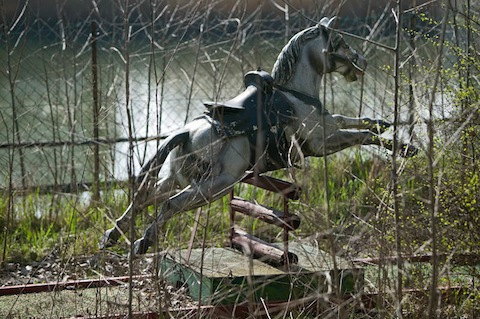
I’m out in California, doing some (very, very, very) last-minute reporting for the book. In my absence, check out these abandoned structures; the ones from Gary, Indiana, are particularly haunting.
April 27, 2012
You Have My Sympathies
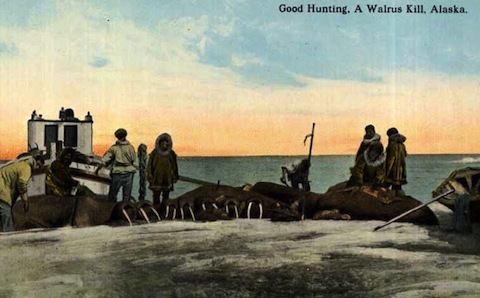
I have exactly one week to go before my book deadline, so expect the next few posts to spin off my last-minute writing struggles.
Over the past several months, I’ve occasionally shouted out great examples of single descriptive details that elevated non-fiction tales into the realm of high art. There was Barbara Demick’s retelling of a North Korean’s manicure-related revelation; Bill Buford on a skinhead disco; and, pehaps most memorably, Mark Bowden’s riff on Pablo Escobar’s depraved leisure preferences. Another recently popped to mind, an analogy from C.J. Chivers that long-ago struck me as a classic. It comes from his 2002 New York Times Magazine piece about walrus hunting:
The revived walrus shoot ranks among the most bizarre hunts ever. Walrus remain protected in the United States, and it is illegal for American hunters to bring home any part of their kills. Instead, they store the skulls, ivory and enormous penis bones in Canada and talk of lobbying Congress to amend the Marine Mammal Protection Act to allow shipment of their curios south. The restrictions hardly deter. Each hunter pays $6,000 to $6,500 to kill a bull, which generally takes a day. It is an achievement that is not surprising, considering that walrus hunting, under Inuit supervision, is the approximate equivalent of a long boat ride to shoot a very large beanbag chair.
That single clause opens up so much psychological depth in the piece. There are a lot of ways that Chivers’ could have denigrated the supposed challenges inherent in hunting stationary animals. But comparing the targets to a cushy staple of Carter-era dorm rooms nails it in a very ingenious way. I can actually see those bean-bag chairs out on the ice floes, waiting to be perforated by rifle bullets. And then hear the unearned whoops of the hunters as they celebrate their faux triumph.
(Postcard via this stellar collection of walrus-related imagery)
April 26, 2012
The First of Many Final Laps

After a day spent haggling with the callous mandarins of America’s health-care system, I’m back to working on the final chapter of the book. I actually came up with a killer last line while walking Microkhan Jr. to school this morning; everything else, alas, is a mess, which is why I’m just leaving you with instructions to check out Jon Rhodes’ photographs of Australia’s rougher precincts. I’m particularly fond of this stout fellow’s joie de vivre.
April 24, 2012
America’s Penchant for Reinvention

Our vast nation’s architectural history boasts few curiosities more delightful than the Nuwaubian pyramids of Eatonton, Georgia, captured here in drive-by video. Some approximation of a backstory is available in this Macon Telegraph story; suffice to say that one must always be wary of religious leaders who were once aspiring musicians. (See also: Koresh, David; Manson, Charles.)
For a glimpse of the pyramids before their bulldozing a few years back, you must check out this awesome Anderson Scott photo essay. Be advised that while the vast majority of the compound was razed, a few of the smaller pyramids were salvaged. Click onwards to discover the fate of one such structure—a reinvention that could not be more thoroughly American.
I’d like to think that the Man from Planet Rizq would get the cosmic joke.
April 23, 2012
Reputational Dynamics
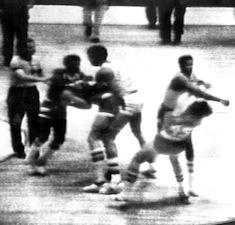 Watching Metta World Peace absolutely lose the plot in yesterday’s Lakers-Thunder contest made me think about the possible legal ramifications of on-court/on-field violence. Much has obviously been written about the possibility of treating such incidents as criminal matters, as has happened on occasion in the Canadian legal system. (The American system, by contrast, seems terribly reluctant to go down that path.) But perhaps the more interesting question is whether sports violence can lead to big-money civil actions. That’s precisely what happened after Houston Rockets guard Rudy Tomjanovich was infamously clocked in the face by Lakers power forward Kermit Washington; Tomjanovich sued the Lakers’ ownership group, arguing that the team had urged its players to act violently, and walked away with a multimillion-dollar settlement.
Watching Metta World Peace absolutely lose the plot in yesterday’s Lakers-Thunder contest made me think about the possible legal ramifications of on-court/on-field violence. Much has obviously been written about the possibility of treating such incidents as criminal matters, as has happened on occasion in the Canadian legal system. (The American system, by contrast, seems terribly reluctant to go down that path.) But perhaps the more interesting question is whether sports violence can lead to big-money civil actions. That’s precisely what happened after Houston Rockets guard Rudy Tomjanovich was infamously clocked in the face by Lakers power forward Kermit Washington; Tomjanovich sued the Lakers’ ownership group, arguing that the team had urged its players to act violently, and walked away with a multimillion-dollar settlement.
What is less known, however, is that Kermit Washington also contemplated filing a suit related to the incident—not against Tomjanovich or his employers, but against the NBA itself. Over twenty years after he threw the punch, Washington had his lawyer send a threatening letter to NBA commissioner David Stern. The text of that bizarre letter is included in John Feinstein’s The Punch:
Kermit feels that the NBA manipulated the situation when it occurred in 1977 for public relations purposes and worked against Kermit with NBA team owners to make Kermit the scapegoat and make the NBA look better to Kermit’s detriment. As a result, Kermit’s ability to flourish as an NBA all-star was undermined and any future opportunities with the league and in the basketball world in general were ruined…
Because of the false light that the NBA has cast Kermit in, every time an incident involving violence in sports comes up, Kermit’s involvement in the Tomjanovich incident and his subsequent suspension are repeatedly established by the NBA as a benchmark. It is our understanding that the NBA released footage of the incident and continues today to cast Kermit in a false light…
Kermit believes that he is entitled to compensation in the amount of five million dollars for the difficulty that he has faced for the last twenty-three years as a result of the actions of the NBA. Kermit has tried to maintain a good relationship with the NBA, but the poor treatment that he has received has pushed him to this point. Five million dollars is a small amount for the NBA to pay for the injustice that Kermit has dealt with for the last twenty-three years.
Once the NBA made clear its intention to vigorously defend itself should a lawsuit be filed, Washington failed to pursue his case. Which is actually too bad—it would have been interesting to see whether a jury could empathize with his plight.
April 20, 2012
Speed Above All
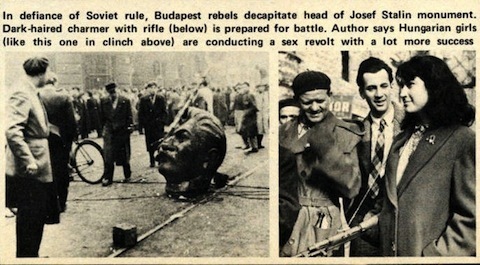
I recently spent the better part of a day trying to verify a single, rather insignificant fact for my next book—namely, whether an interviewee’s claim to have received a certain model of Omega watch in early 1978 jibed with Omega’s production schedule. (It did.) Having expended way too much mental bandwidth to accomplish that one reportorial task, I can’t help but wonder how much better life would be if contemporary non-fiction operated according to the rules of Cold War-era pulp magazines. Because as this interview with the writer behind an article entitled “Budapest’s Sex Revolt” makes clear, accuracy was the least of that industry’s concerns:
You wrote hundreds of action, adventure and war stories for men’s adventure magazines. Did you also write a lot of “sex exposé” stories and were they your ideas or suggested by editors?
DORR: I wrote dozens of sex exposé stories and I did it all without having sex with anybody. With one exception involving one article, no editor ever suggested a topic to me. I simply looked at what the magazines were publishing and tried to copy it.
The Budapest story has references to true history and a lot of details about the city. How much was based on personal knowledge versus imagination?
DORR: I’ve never been to Budapest. I don’t remember how I wrote the story. I believe “pure imagination” was a big factor. Remember that any place with a faraway name was deemed exotic back in 1970 and not very many other Americans had ever been to Budapest, either.
Keep that in mind the next time some media pundit tries to convince you that the seventies were some sort of Golden Age of reportorial truth. Woodward and Bernstein were the exception, not the rule.





